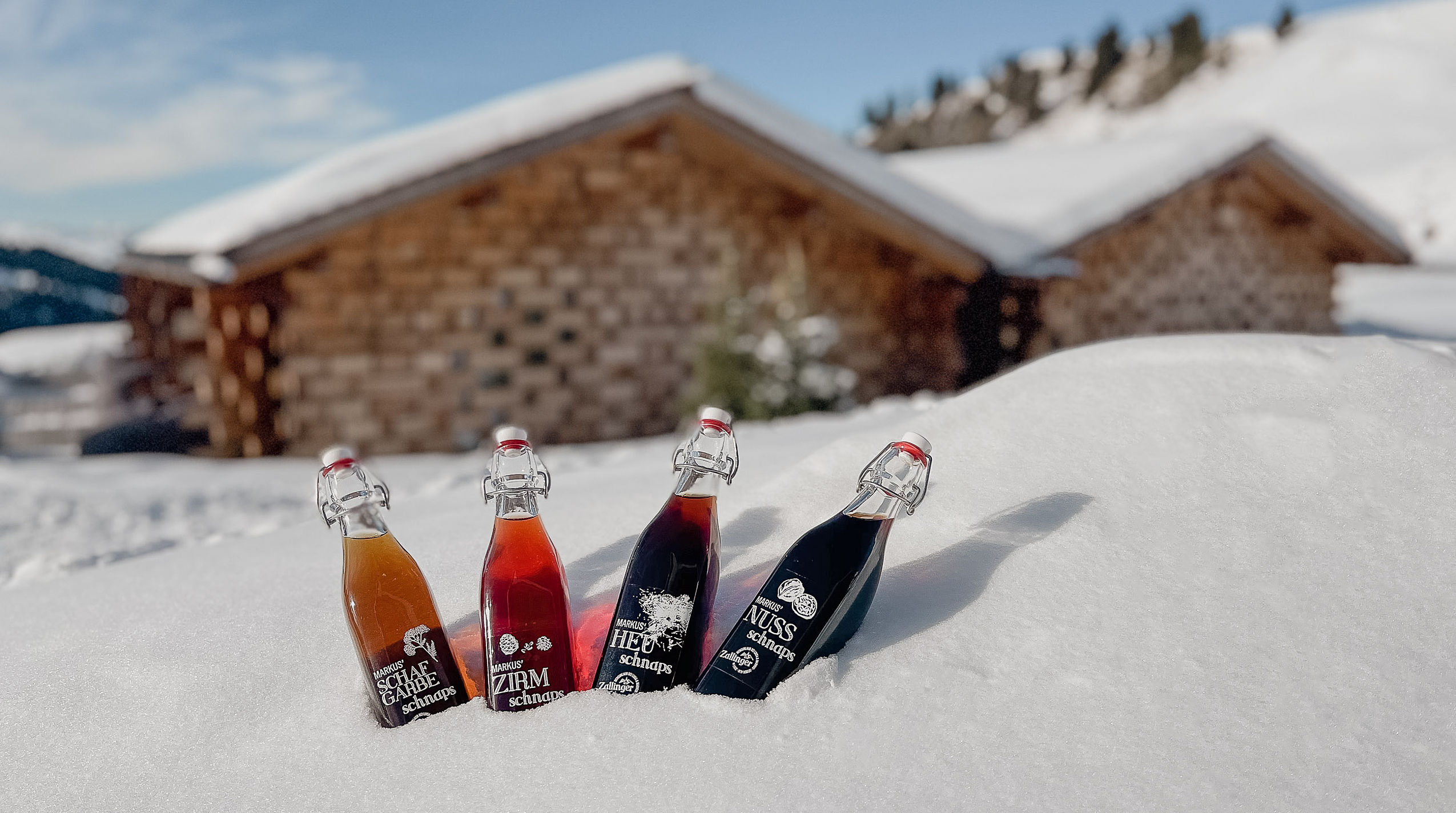Imagine you were to get your hands on a genie. What would you wish for? Eternal youth, perhaps? Everlasting health? Or bear powers? Then read on, because up here in Zallinger's magic kitchen, very special elixirs are created. But from the beginning. Don't think we're in league with the devil. Quite the opposite. The plants and herbs we cork for you are a gift from heaven. High-percentage good luck charms, pick-me-ups and health promoters. Before we introduce you to our genies in more detail, we would like to get one thing off our chest: We don't want to encourage you to drink alcohol here, as you know: the dose makes the poison. And our genies should be tasted with care and pleasure. And now we'll tell you how we bottle the miraculous powers of nature.
Zallinger's high-proof genies in the bottle

The cough extinguisher: Zirmschnaps (Swiss stone pine schnapps)
It is the queen of the Alps, a tree to which all kinds of mighty power has been attributed since time immemorial: the Swiss stone pine. Also known as Swiss stone pine or Arbe, this high alpine plant is highly prized. Anyone who has ever slumbered in a stone pine bedroom knows why. The essential oils of the stone pine are said to lower blood pressure and heart rate and have a positive effect on the immune system. The Swiss stone pine gets its name from the old German word "zirben", which means "to turn in a circle". This in turn has to do with the seeds of the tree, which are popularly called "stone pine nut". Although not a real nut, its harvesting time is the crux of a perfect Zirbelnschnaps. They have to be red and still full of juice, the stone pine nuts. If you want them, you need strength, stamina and courage. Because they can only be picked by hand. Once this is done, the pine cones are cut into slices and preserved in high-proof spirit for several weeks. Filtered and refined with sugar or honey, the Zirm gets its final touch. Even great-grandmother knew: if you have a stubborn cough, drink a sip of "Zirmlikör"! By the way: the Swiss stone pine has something like a little sister, the mountain pine. We also love to make fine liqueur from its cones.
The Lightbringer: Nut Liqueur
Some may think we are superstitious fools, but we can't take a joke when it comes to making our "Nussila". The green, soft fruits of the walnut tree are harvested on the night of 23-24 June. Not a day earlier, not a day later. For only when they are picked, cut and preserved in alcohol on St. John's Eve can the nut schnapps develop its full strength. This mixture is then refined with all kinds of spices. Of course, we don't reveal exactly what we use, but there is always a bit of mint, cinnamon and star anise. Many weeks later, at the time of the winter solstice, the time has come: the Nussila is ready. We call it the "light bringer" or "sun in a glass". When you taste it, you know what we mean. It's almost as if a bit of summer power flows down your throat directly into your soul and warms your heart.
The time capsule: Hay schnapps
It reminds you of a summer like back then. Of carefree days in the mountains. Of summit happiness and sky blue. And of that irrepressible feeling of freedom that you can only feel on the Alpe di Siusi. It is not at all a schnapps idea to mix the finest, hand-cut alpine meadow hay with high-proof alcohol. The keyword is "spiked": Apart from the power of the many secondary plant substances and the essential oils, the magic of alpine hay schnapps lies in its aroma. One sip and bang: you feel like you're on a summer holiday at the Zallinger. How? You've never been on a summer holiday with us? Then you've just had a little taste. And here you can read about what to expect.
The antispasmodic: yarrow liquor
You've reached into the soup pot or the snack drawer a bit too boldly? Are your period cramps bringing you to your knees? Then pour yourself a glass of yarrow. It has been proven that peasant doctors and herb women have known this recipe since the 16th century. In some parts of the Alps, yarrow schnapps is considered a tonic for sturdy hunters. They are also the ones who know where the most beautiful and best yarrows grow: namely near rock and stone. In addition to tea and syrup or wild herb salads, the drink, prepared with sugar or honey, is a boon for flatulent stomachs. Give it a try!
